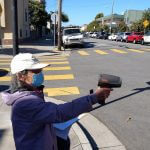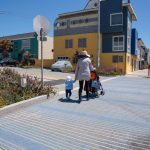At last, the silence on traffic violence is broken at the national level
Almost exactly two years ago, Steve Bingham was more than willing to risk arrest at the first-ever presidential candidate forum on infrastructure issues.
That evening, I watched Steve grow increasingly frustrated as the candidates covered so many topics – but not once discussing the fact that 40,000 people die and 3 million people are injured in traffic crashes each year on our roads.
Steve suddenly stood. He held up a large photo of his daughter, Sylvia. Sylvia, a recent college graduate, was riding her bicycle to her new job when she was struck and killed by a hit-and-run truck driver.
Jeri Lynch stood, too. Jeri’s son Conor was training with his high school cross country team when he was killed by a distracted, unlicensed driver.
Unfurled between them was a banner reading “End the Silence on Traffic Violence.” The event police headed our way, and their act of protest ended.
Fast forward to last week, when it felt as though the silence on traffic violence at the federal level was finally broken. And what a relief, especially for people in the Families for Safe Streets community like Steve and Jeri, who have experienced tragic traffic crashes firsthand.
“Our goal is this: Zero. Zero traffic deaths.”
Those words were spoken by Transportation Secretary Pete Buttigieg on January 28 at the release of the US Department of Transportation’s new National Roadway Strategy.
For Secretary Buttigieg to embrace Vision Zero and focus on the national crisis in traffic deaths is meaningful.
But what’s in the new National Roadway Strategy is groundbreaking. The Strategy takes on traffic safety with a ‘safe systems’ approach for the first time, including safe road design, safe vehicle design, and safe driver behavior. Read an analysis of what’s in the Strategy by the Vision Zero Network.
At the same time, we’re seeing a seismic shift in transportation funding priorities. The new Infrastructure Investment and Jobs Act includes $14 billion dollars nationally for safety projects to reduce vehicle speeds, calm traffic, and create protected intersections and bikeways, among other life-saving improvements. Families for Safe Streets and Walk San Francisco celebrated this with House Speaker Nancy Pelosi and others last month.
Families for Safe Streets members, here in the San Francisco Bay Area and across the nation, put their hearts and souls into winning change so others don’t have to suffer like they have.
Stephen, Jeri, and others are meeting with members of Congress, urging them to pass a federal resolution in support of zero traffic deaths by 2050. Here in San Francisco, they tell their stories and push leaders to do everything in their power to prevent severe and fatal crashes.
I’m so grateful for their voices. Their voices are why the silence on traffic violence has finally, truly been broken.
San Francisco Bay Area Families for Safe Streets brings together people who have had someone they care about hurt or killed in a traffic crash. It also includes people who have survived a traffic crash themselves.
Families for Safe Streets also helps people channel their grief into action. We use our voices to push for the changes needed to prevent more tragedies. We are part of a national Families for Safe Streets movement.
Contact Aly at aly@walksf.org with questions about San Francisco Bay Area Families for Safe Streets. Walk San Francisco provides support and guidance to Families for Safe Streets.




